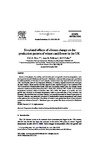Simulated effects of climate change on the production pattern of winter cauliflower in the UK
| dc.contributor.author | Wurr, DCE | |
| dc.contributor.author | Fellows, JR | |
| dc.contributor.author | Fuller, MP | |
| dc.date.accessioned | 2013-03-03T17:37:57Z | |
| dc.date.available | 2013-03-03T17:37:57Z | |
| dc.date.issued | 2004-01-01 | |
| dc.identifier.issn | 0304-4238 | |
| dc.identifier.issn | 1879-1018 | |
| dc.identifier.uri | http://hdl.handle.net/10026.1/1439 | |
| dc.description.abstract |
Models of the phases of juvenility, curd induction and curd growth, driven by temperature, were developed for Roscoff, Walcheren and Roscoff× Walcheren winter cauliflower types and were linked to enable prediction of the time of curd maturity. Because some crop types in Cornwall (west of UK); Lincolnshire (east of UK) responded differently to weather, separate models were developed for each location. These models were then applied to each cauliflower type at four locations in the UK (Cornwall and Pembrokeshire (west); Kent and Lincolnshire (east)) using four climate impact emissions scenarios and three time-slices (2011-2040, 2041-2070 and 2071-2100). In all forecasts temperatures increased relative to baseline data (1961-1990). The phases of juvenility and curd growth were shortened by increased temperature, while in most cases that of curd induction was increased. The net effect was to advance maturity in all situations except for Roscoff types grown in Cornwall. Maturity was particularly advanced in Pembrokeshire because temperatures were closest to the optimum for curd induction. The effects of location were greater than those of time-slice and scenario and effects on Roscoff×Walcheren types were greater than those on Roscoff or Walcheren types. © 2004 Elsevier B.V. All rights reserved. | |
| dc.format.extent | 359-372 | |
| dc.language | en | |
| dc.language.iso | en | |
| dc.publisher | Elsevier BV | |
| dc.subject | temperature | |
| dc.subject | juvenility | |
| dc.subject | induction | |
| dc.subject | curd growth | |
| dc.subject | maturity | |
| dc.subject | model simulation | |
| dc.title | Simulated effects of climate change on the production pattern of winter cauliflower in the UK | |
| dc.type | journal-article | |
| dc.type | Journal Article | |
| plymouth.author-url | https://www.webofscience.com/api/gateway?GWVersion=2&SrcApp=PARTNER_APP&SrcAuth=LinksAMR&KeyUT=WOS:000224237700002&DestLinkType=FullRecord&DestApp=ALL_WOS&UsrCustomerID=11bb513d99f797142bcfeffcc58ea008 | |
| plymouth.issue | 4 | |
| plymouth.volume | 101 | |
| plymouth.publication-status | Published | |
| plymouth.journal | Scientia Horticulturae | |
| dc.identifier.doi | 10.1016/j.scienta.2003.11.011 | |
| plymouth.organisational-group | /Plymouth | |
| plymouth.organisational-group | /Plymouth/Faculty of Science and Engineering | |
| plymouth.organisational-group | /Plymouth/Faculty of Science and Engineering/School of Biological and Marine Sciences | |
| plymouth.organisational-group | /Plymouth/REF 2021 Researchers by UoA | |
| plymouth.organisational-group | /Plymouth/REF 2021 Researchers by UoA/UoA06 Agriculture, Veterinary and Food Science | |
| plymouth.organisational-group | /Plymouth/Users by role | |
| plymouth.organisational-group | /Plymouth/Users by role/Academics | |
| dc.identifier.eissn | 1879-1018 | |
| dc.rights.embargoperiod | Not known | |
| rioxxterms.versionofrecord | 10.1016/j.scienta.2003.11.011 | |
| rioxxterms.licenseref.uri | http://www.rioxx.net/licenses/all-rights-reserved | |
| rioxxterms.type | Journal Article/Review |


